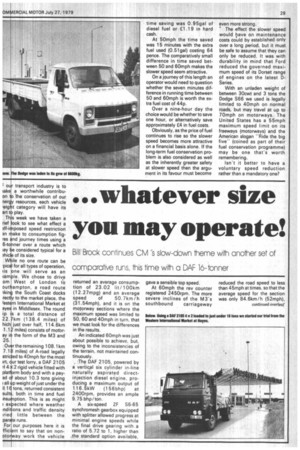• • • whatever size you may operate!
Page 31

Page 32

If you've noticed an error in this article please click here to report it so we can fix it.
Bill Brock continues CM "s slow-down theme with another set of comparative runs, this time with a DAF 16-tanner
o r transport industry is to lake a worthwhile contribuon ii ihe conservation of our ner y resources, each vehicle reig t category will have its ant. play.
Th s week we have taken a rief ook to see what effect a alf-i posed speed restriction an ake to consumption figres nd journey times using a 6-to ner over a route which lay e considered typical for a ahic of its size.
W ile no one route can be 'pie I for all types of operation, us •ne will serve as an cam le. We chose to drive om West of London to out ampton, a road route ikin the South Coast docks rect y to the market place, the fest rn International Market at aye in Middlesex. The round ip s a total distance of 22. km (138.4 miles) of hich just over half, 114.6km 1.1 miles) consists of motoray i the form of the M3 and 25.
Ov r the remaining 108.1km 7.1 1 miles) of A-road legally stric ed to 40mph for the most ur test lorry, a DAF 2105 -I 4 2 rigid vehicle fitted with pla '.rm body and with a pay ad about 10.3 tons giving all p weight of just under the II 1 tons, returned consistent suit, both in time and fuel nsu ption. This is as might ex ected where weather ndi ions and traffic density irie little between the par e runs.
For our purposes here it is ffici nt to say that on nonoto ay work the vehicle returned an average consumption of 23.02 lit/100km (12.27mpg) and an average speed of 50.7km /h (31.54mph), and it is on the motorway sections where the maximum speed was limited to 50, 60 and 40mph in turn, that we must look for the differences in the results.
An indicated 60mph was just about possible to achieve, but, owing to the inconsistencies of the terrain, not maintained continuously.
The DAF 2105, powered by a vertical six cylinder in-line naturally aspirated directinjection diesel engine, producing a maximum output of
116.5kW (156bhp) at 2400rpm, provides an ample 9.75 bhp/ton.
A six-speed ZF 56-65 synchromesh gearbox equipped with splitter allowed progress at minimal engine speeds while the final drive gearing with a ratio of 5,72 to 1, higher than the standard option available, gave a sensible top speed.
At 60mph the rev counter registered 2450rpm. The more severe inclines of the M3's southbound carriageway reduced the road speed to less than 45mph at times, so that the average speed for the section was only 84.6km /h (52mph), while northbound, with a greater amount of downhill running, better averages of 89km / h (55.6mph) were produced.
Very few commercial vehicles, even unladen ones, found the speed to pass us. An overall fuel consumption of 24.4 lit/100km (11.59mpg) was recorded for the total distance, but on the motorway only 25.6 lit/100km (11.02 mpg).
With the top speed reduced to 50mph, at an engine speed of 2100rpm, there were many more vehicles overtaking us than we in turn were able to overtake. Owing to the lower initial speed and reduced impetus with which to charge the gradients, at times the road speed fell to a much lower level, but we still were able to average 72km /h (45mph), and over the complete distance 60km /h (37.3mph) while returning 22.4 lit/100km (12.6mpg) and 22.6 lit/100km respectively.
Concentration
Without doubt, 40mph is a very boring speed to have to travel on the motorway and concentration of the driver of the vehicle tends to wander or is easily distracted. Maximum torque is produced in the OAF at 1600rpm and, while top gear is used, this corresponds almost exactly to our third speed restriction of 40mph. With the single exception of a local authority's sludge gulper, no vehicle appeared to be travelling below our speed.
But our patience paid off in terms of fuel saving. In one direction we returned just over 17mpg. After all the figures were included the vehicle still returned 20.8 lit /100km (13.57mpg).
These test runs, limited though they may be, show that fuel can be saved by travelling slower. The consumption difference over the 222.7km (138.4 miles) route between 60 and 40mph maximum speed: was just 7.9 litres (1.74ga1).
If a larger proportion o motorway running was in cluded, the savings would b( even greater.
With the route describe( here, though, it would not b( unreasonable to complete tw( round trips a day. Over the year assuming an average of fiv( working days a week and fue priced at £1 .30 a gallon, travel ling at no faster than 40mpl could save the operator a total o £1,176, or 904 gallons of der for each vehicle, which is 3.: per cent saving overall.
Where operational condi tions allow it would seem ti make sense for the maximun speed to be limited, but there i another factor to be considered and that is one of time. In ou example it would have takei one hour eight minutes longer t complete the working day at th slower speed.
If tnis meant extra cost i wages then the financial advar tage would soon be lost, there are still extra hidden ben( fits to consider: lower speed put less strain on the drive line brakes and tyres. However, thi reduction in wear is less easil evaluated.








































































































